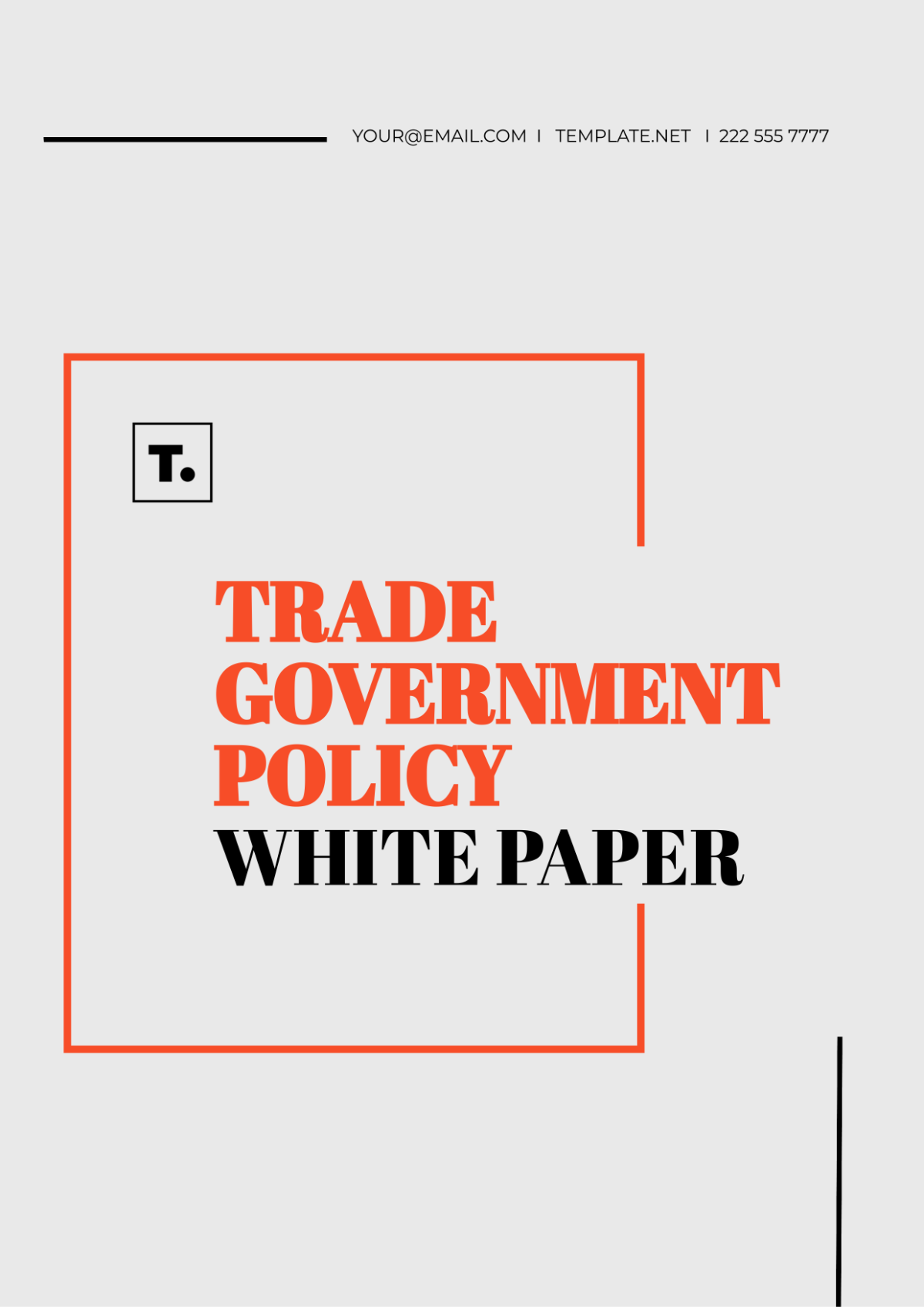TRADE GOVERNMENT POLICY WHITE PAPER
Prepared by: [YOUR NAME]
Organization: [YOUR COMPANY NAME]
Department: [YOUR DEPARTMENT]
Date: [DATE]
I. Executive Summary
The Executive Summary offers a succinct overview of the white paper's analysis of international trade policies. It highlights the significance of trade agreements, tariffs, and barriers on industries and consumers, emphasizing the need for strategic adaptation. Recommendations include advocating for trade liberalization, enhancing regulatory transparency, and investing in innovation to bolster competitiveness.
II. Introduction
 A. Background
A. Background
International trade plays a pivotal role in the global economy, fostering economic growth, and driving innovation. As [Your Company Name] expands its global footprint, understanding and shaping government policies related to international trade are paramount. Trade agreements, tariffs, and trade barriers significantly impact market access and competitiveness.
B. Purpose
The purpose of this white paper is to analyze existing government policies in international trade and provide recommendations for improvement. By evaluating the effectiveness of trade agreements and assessing the implications of tariffs and trade barriers, [Your Department] aims to optimize trade relations and enhance the company's competitiveness in the global marketplace.
III. Analysis of Trade Agreements
A. Overview
Trade agreements establish the framework for international trade by regulating tariffs, quotas, and other trade-related policies. These agreements aim to promote fair competition, facilitate market access, and stimulate economic growth. However, the effectiveness of trade agreements varies depending on their scope and implementation.
B. Case Studies
Case studies of prominent trade agreements, such as the North American Free Trade Agreement (NAFTA) and the Comprehensive and Progressive Agreement for Trans-Pacific Partnership (CPTPP), provide insights into their impact on [Your Company Name]'s operations. Analyzing the benefits and challenges of these agreements informs strategic decision-making and market expansion efforts.
IV. Tariffs and Trade Barriers
A. Tariff Analysis
Tariffs, or taxes imposed on imported goods, directly influence the cost of doing business internationally. High tariffs can increase production costs and reduce competitiveness, while low tariffs enhance market access and promote trade liberalization. Analyzing tariff structures and trends is crucial for the department's pricing strategies and supply chain management.
B. Non-Tariff Barriers
Non-tariff barriers, such as product standards, licensing requirements, and customs procedures, create additional obstacles to international trade. Understanding and addressing these barriers are essential for streamlining trade processes and minimizing operational disruptions. Collaborating with regulatory authorities and industry associations can help navigate complex compliance requirements.
V. Implications for Domestic Industries
A. Sectoral Analysis
Different industries are affected differently by government trade policies. For example, the manufacturing sector may benefit from reduced tariffs on imported raw materials, while the agricultural sector may face stiff competition from subsidized foreign producers. Conducting a sectoral analysis enables the department to identify growth opportunities and mitigate risks within each industry segment.
B. Competitiveness
Competitiveness in the global marketplace depends on various factors, including technological innovation, workforce skills, and regulatory environment. Assessing the competitive landscape helps the company identify strengths to leverage and weaknesses to address. Investing in research and development, talent acquisition, and process optimization enhances the department's long-term competitiveness.
VI. Implications for Consumers
A. Consumer Welfare
Government trade policies influence consumer welfare by shaping product availability, quality, and pricing. Lowering trade barriers can lead to greater product diversity and lower prices for consumers, while protectionist measures may limit choices and increase costs. Analyzing consumer preferences and market trends guides the company's product development and marketing strategies.
B. Consumer Protection
Ensuring consumer protection in international trade is essential for building trust and confidence in the company's brand. Compliance with safety standards, product labeling requirements, and consumer rights regulations demonstrates [Your Department]'s commitment to ethical business practices. Investing in quality assurance and customer support strengthens the company's reputation and loyalty.
VII. Global Economic Integration
A. Economic Interdependence
[Your Company Address] is intricately connected to the global economy through trade, investment, and financial flows. Deepening economic integration fosters collaboration and mutual prosperity among nations. Engaging in international forums and partnerships promotes the company's interests while contributing to sustainable development goals.
B. Multilateral Cooperation
Addressing complex global challenges, such as climate change and cybersecurity, requires collective action and cooperation among governments, businesses, and civil society organizations. Advocating for multilateral initiatives and partnerships enhances the company's reputation as a responsible corporate citizen and strengthens its social license to operate.
VIII. Recommendations
Based on the analysis presented, the department offers the following recommendations to optimize government policies in international trade:
Promote Trade Liberalization: Advocate for the removal of trade barriers and the negotiation of mutually beneficial trade agreements to expand market access and stimulate economic growth.
Enhance Regulatory Transparency: Improve transparency and predictability in trade regulations to reduce compliance costs and facilitate cross-border trade.
Invest in Innovation and Skills Development: Support research and development initiatives and invest in workforce training to enhance the company's competitiveness and adaptability in a rapidly evolving global economy.
Strengthen Stakeholder Engagement: Collaborate with industry associations, government agencies, and civil society organizations to address common challenges and promote sustainable business practices.
IX. Conclusion

In conclusion, analyzing and shaping government policies in international trade is essential for [Your Company Name]'s success in the global marketplace. By understanding the implications of trade agreements, tariffs, and trade barriers on domestic industries and consumers, The Department can formulate informed strategies to enhance competitiveness and drive sustainable growth. Collaboration with stakeholders and advocacy for policy reforms are key to achieving these objectives.
X. Appendices
Appendix A: Glossary of Trade Terms
Appendix B: Statistical Data on International Trade Flows
Appendix C: Case Studies of Trade Agreements
Appendix D: Consumer Survey Results
Appendix E: Regulatory Compliance Checklist
White Paper Templates @ Template.net

 A. Background
A. Background





























